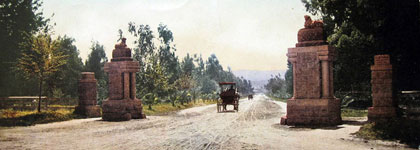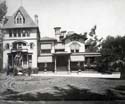|
Gallery | Campus Structures | Entrance & Palm Drive
The addition of the long approach to the University along what we now know as Palm Drive was not added to the general campus plan until April 1888. This was extremely late in the planning process - the Laying of the Cornerstone ceremony had taken place almost a year earlier and construction of the Quad was already underway. A letter from Frederick Law Olmsted to Leland Stanford indicates that Leland had asked for changes. Olmsted wrote, "We are now engaged upon a series of drawings which it is expected will be complete ... before the end of the month. These will include one showing a considerable variation from the original general plan and an extension of it to include on one side an Arboretum and several hundred acres of forest plantations on the foot hills, and on the other an avenue to a proposed railway station." All three of the drawings Olmsted sent included the Palm Drive approach through an expanded arboretum ending in an oval-shaped drive in front of the Quad. This addition echoes an earlier wish for an "enormously large approach" the Stanfords had expressed to architect Charles Coolidge in May of 1887.
At the Palo Alto end of Palm Drive, a modest set of entrance gates was initially built . These were later rebuilt into something more monumental during the 1899-1905 construction boom headed up by Jane Stanford. Unfortunately, this entrance completely collapsed during the 1906 earthquake and a new entrance had to be constructed.
To the west of Palm Drive, the Stanfords had constructed their Palo Alto home back in the days when the property was still a ranch. It was at this time that the cactus garden was added. Later, the Mausoleum and Angel of Grief would also be built. The Mausoleum originally had female sphinxes guarding its doors, but Jane Stanford asked for them to be removed and replaced with male sphinxes. The female sphinxes were placed in the back of the building, where they remain today. The Mausoleum suffered no damage in the 1906 quake, but the Stanford home was badly shaken and much of the house collapsed. Only the servants' wing survived. The Angel of Grief, a marble sculpture erected in memory of Jane Stanford's brother, Henry Clay Lathrop, originally had a canopy, but this fell during the quake and damaged the Angel below. Further injury was inflicted by souvenir hunters who broke off the Angel's hand.
Digital images from the Stanford University Archives represented on this site may be viewed freely. These images may not be reproduced or used for any purpose without permission. For permission requests please contact the Office of the University Archivist
Questions or comments? Email the Web Manager
|






















